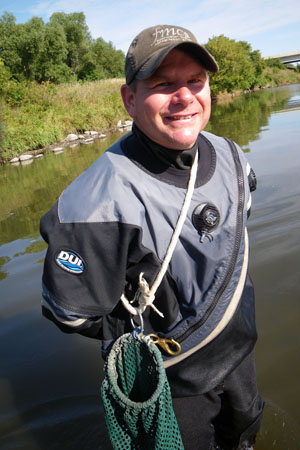Bernard E. Sietman
Malacologist with the Minnesota DNR
You would be hard press to find anyone as passionate and knowledgeable about mussels as Bernard Sietman, a transplanted Missourian. Bernard and Mike Davis work together as the two malacologists for the MN DNR coordinating the statewide mussel survey and other related projects. In this position Bernard likes to root around in the mud looking for elusive bivalve mollusks, and save imperiled species from imminent doom just like Superman. One of the more exciting aspects of this job for Bernard is the potential discovery of a new species for the Minnesota River Basin, the Mapleleaf.
Bernard received his Master of Science degree in Biology from the Emporia State University where he studied the ecology and genetics of freshwater mussels in two local rivers. After graduation he worked as a Natural History Biologist for the Missouri Department of Conservation surveying freshwater mussels, conducting landowner interviews and assisting with stream fish surveys. Sietman spent time as an Aquatic Ecologist and Assistant Technical Scientist with the Illinois Natural History Survey. Here he assisted with overseeing of a nationally renowned mollusk and fish collections.
In July of 2002, Bernard E. Sietman took this job with the MN DNR in the St. Paul office sampling freshwater mussel and snail communities in rivers and lakes. One of the highlights was the publication of the “Field guide to the freshwater mussels of Minnesota.” Sietman serves on the Mussel Conservation Team member for a multi-state/federal agency propagation and reintroduction program for the Federally Endangered Lampsilis higginsii and Quadrula fragosa. In this position, Bernard travels across Minnesota conducting mussel surveys, leading mussel hikes for the public and conducting research on the mussel reproduction cycle.
“The Minnesota River had an outstanding mussel assemblage historically. As a matter of fact, one of the early explorers to the [basin] Featherstonhaugh did a book on his exploits on the Minnesota River saying he could bury his arm could pick up all kinds of muckets in the river. Unfortunately, the muckets no longer exist in the Minnesota River mainstem. They used to be very, very common but are now gone. Historically, the Minnesota River was great. It had a big river mussel fauna in the lower reach and as you went upstream you got into the tributaries it had their assemblages of species that got upstream and into the creeks the species that only live in creeks.”
“I was first introduced to freshwater mussels in my first class as a graduate student that I took at my undergraduate university Southwest Missouri State. My first graduate level course was aquatic invertebrates class. That was the first time I was really introduced to mussels. I gravitated towards going out and collecting mussels because you got to get into the river and grub around on your hands and knees and you didn’t know what you were going to get until you picked it up. It was like looking for treasure almost in the river. I just loved that. In addition, the shapes and the sizes, the colors, and the sculptures. They are so diverse in North America. It is why people gravitate towards birds and butterflies because of the color, because of variation and mussels are incredibly variable. That was another draw just the neatness of them. That is why people go collecting shells along the beach along the ocean. People love collecting shells because they are so neat and beautiful. That was another thing. When I started to learn about their biology they probably have one of the most interqute and interesting life histories of any animal in North America. A sort of parasitic lifecycle that involves all of these lures and mimicry. It was something that really sealed it and I’ve been working on them pushing twenty years now and don’t plan on stopping."
MEET THE EXPERT VIDEO



